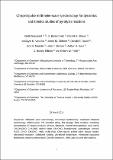Chirped-pulse millimeter-wave spectroscopy for dynamics and kinetics studies of pyrolysis reactions
Author(s)
Vasiliou, AnGayle K.; Oldham, James M.; David, Donald E.; Muenter, John S.; Stanton, John F.; Suits, Arthur G.; Barney Ellison, G.; Field, Robert W.; Prozument, Kirill; Park III, George Barratt; Shaver, Rachel Glyn; Field, Robert W; ... Show more Show less
DownloadChirped.pdf (1.035Mb)
OPEN_ACCESS_POLICY
Open Access Policy
Creative Commons Attribution-Noncommercial-Share Alike
Terms of use
Metadata
Show full item recordAbstract
A Chirped-Pulse millimeter-Wave (CPmmW) spectrometer is applied to the study of chemical reaction products that result from pyrolysis in a Chen nozzle heated to 1000 – 1800 K. Millimeter-wave rotational spectroscopy unambiguously determines, for each polar reaction product, the species, the conformers, relative concentrations, conversion percentage from precursor to each product, and, in some cases, vibrational state population distributions. A chirped-pulse spectrometer can, within the frequency range of a single chirp, sample spectral regions of up to ~10 GHz and simultaneously detect many reaction products. Here we introduce a modification to the CPmmW technique in which multiple chirps of different
spectral content are applied to a molecular beam pulse that contains the pyrolysis reaction products. This technique allows for controlled allocation of its sensitivity to specific molecular transitions and effectively doubles the bandwidth of the spectrometer. As an example, the pyrolysis reaction of ethyl nitrite, CH[subscript 3]CH[subscript 2]ONO, is studied at different
temperatures of the Chen reactor, and CH[subscript 3]CHO, H[subscript 2]CO, and HNO products are simultaneously observed, exploiting the multi-chirp CPmmW technique. Rotational and vibrational temperatures of some product molecules are determined. Subsequent to supersonic expansion from the heated nozzle, acetaldehyde molecules display a rotational
temperature of 4 ± 1 K. Vibrational temperatures are found to be controlled by the collisional cooling in the expansion, and to be both species- and vibrational mode-dependent. Rotational transitions of vibrationally excited formaldehyde in levels ν[subscript 4], 2ν[subscript 4], 3ν[subscript 4], ν[subscipt 2], ν[subscript 3], and ν[subscript 6] are observed and effective vibrational temperatures for modes 2, 3, 4, and 6 are determined and
discussed. Keywords: millimeter wave spectroscopy, microwave spectroscopy, broadband rotational spectroscopy, chirped pulse, free induction decay, fast passage, flash pyrolysis, branching, concentration of reaction products, kinetics, dynamics, thermal decomposition, ethyl nitrite,
CH[subscript 3]CH[subscript 2]ONO, C[subscript 2]H[subscript 5]ONO, methyl nitrite, CH[subscript 3]ONO, formaldehyde, acetaldehyde, nitroxyl, H[subscript 2]CO, CH[subscript 2]O, CH[subscript 3]CHO, HNO, multi-chirp, Chen nozzle, pulsed valve, tubular reactor, vibrational relaxation, collisional cooling, vibrational temperature, vibrational population distribution, rotational temperature, Coriolis interaction, ortho, para, nuclear spin statistics.
Date issued
2014-03Department
Massachusetts Institute of Technology. Department of ChemistryJournal
Physical Chemistry Chemical Physics
Publisher
Royal Society of Chemistry (RSC)
Citation
Prozument, Kirill, et al. “Chirped-Pulse Millimeter-Wave Spectroscopy for Dynamics and Kinetics Studies of Pyrolysis Reactions.” Phys. Chem. Chem. Phys., vol. 16, no. 30, 2014, pp. 15739–51.
Version: Author's final manuscript
ISSN
1463-9076
1463-9084